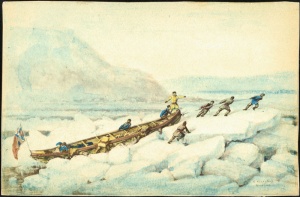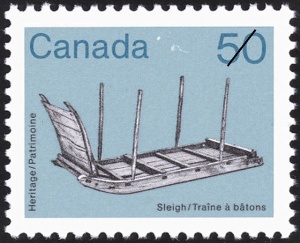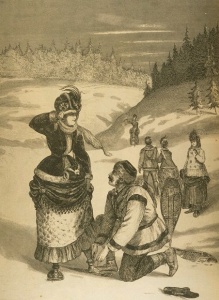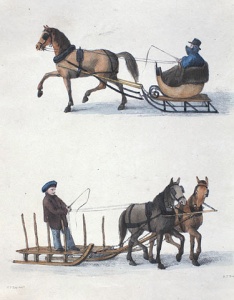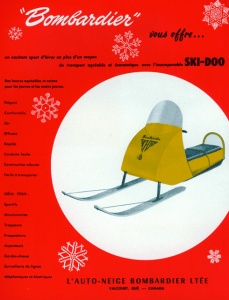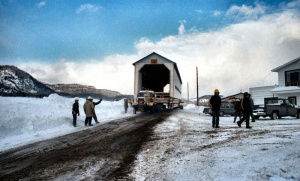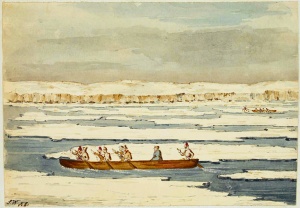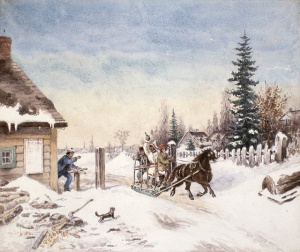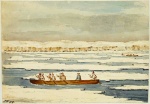Adapting to Winter: Transportation
par Ferland, Catherine and Fournier, Martin
Winters in Quebec are long and harsh. When the first French immigrants settled on the banks of the Saint Lawrence, adapting to Quebec’s winter was a major challenge. Every aspect of day-to-day living was affected—agriculture and food supply, transportation, lodging, clothing, human relations, and culture. Amerindians were instrumental in helping the settlers to adapt. Then, as one generation gave way to the next, the ingenuity of the inhabitants and their determination to alleviate the hardships of winter led to the invention of ever more effective tools and equipment and the development of new ways of dealing with the harsh conditions. Today, Quebeckers can take part in most of the same activities year round—a situation that was still inconceivable not so long ago. Our gradual adaptation to winter marks our history and our heritage and provides the artifacts that fill our museums and our memories.
Article disponible en français : Adaptation à l’hiver : l’exemple des transports
Winter: an Obstacle to be Tamed
Adapting means of transportation to winter conditions was unavoidable. Wheeled carts could make no progress when the ground was thick with snow; longboats could not sail on frozen water; even pedestrians had trouble getting from place to place. Natives had found solutions to these problems long before, and the French settlers lost no time in adopting these solutions. Snowshoes became commonplace, as did toboggans, or “Indian sledges,” which made it easy to transport merchandise by sliding it over the snow. The toboggan would soon evolve into a winter horse-drawn carriage. And settlers quickly came up with their own version of a sturdy ice canoe, based on the birch-bark models already in use by natives.
Over time, these early means of winter transportation were displaced by more efficient technological innovations, such as snowmobiles, four-wheel-drive vehicles fitted with winter tires, and icebreaker ships. Yet the ancestral methods are still very much a part of our modern-day society, in sports and leisure activities, and in our heritage. They remind us of the essential steps that the people of this area had to take to surmount the harsh realities of the Canadian winter. Quebeckers’ adaptation of existing means of transportation for use in winter demonstrates their resiliency and inventiveness in overcoming the harsh realities of their environment.
Snowshoes—from Transportation to Sporting Activity
The first inhabitants of New France had to borrow snowshoes from the Amerindians to get around on foot when snow lay thick on the ground. These snowshoes were made from sinew (leather thongs) knotted and braided on a wooden hoop. They spread the weight of walkers over a wide surface to prevent their sinking into the snow. There were several models, with sizes and shapes varying according to the type of snow and the primary qualities sought (bearing capacity, manoeuvrability, suitability to speedy travel, and so on). Just like the Amerindians, the Canadiens (French people born in the Saint Lawrence Valley) were known for their endurance and skill at getting around on snowshoes. They could cover several kilometres in a single day, running in snowshoes, keeping to the frozen rivers, where obstacles were fewer in number (NOTE 1). The troops of Canadian and native militiamen led by the brothers Le Moyne (Jacques Le Moyne de Sainte-Hélène and Pierre Le Moyne d'Iberville), to name one example, crossed considerable distances in snowshoes to strike British villages and outposts from New England to Newfoundland in the 1690s.
During the 19th century, snowshoeing became a very popular leisure activity. The Montreal Snowshoe Club was founded in 1843. It was the first such club in North America, but many other clubs soon followed suit. Each club had its gathering place—a chalet, inn, or meeting hall—where snowshoers could socialize over a good meal or a game of cards after their outings. French-Canadian snowshoers gathered under the banner of the Union canadienne des raquetteurs and the Union des raquetteurs du district de Québec. The membership base included several Franco-American contingents. Large-scale events drew participants in the thousands, right up until the last snowshoers’ convention held in Quebec City in 1962. After a period of decline, this activity has experienced a resurgence of popularity in the early 21st century, thanks in part to improvements that make snowshoes lighter, tougher, and better suited to sharp rises and dips in the terrain.
“Just hear those sleigh bells jingling...”
The first “revolution” in winter transportation occurred when the Canadiens started to hitch oxen, then (beginning in 1670) horses to toboggans, which were modified to yield a larger and more practical vehicle. Like the toboggans, the new “winter carriages” were flat and fitted with two rounded runners so they could slide easily over the snow. Over time, various improvements would make these “winter carriages” the favoured vehicles for getting around in winter, well into the 20th century. The earliest modifications consisted in adding a snow-shield panel to the broadened toboggan in the front, and vertical, spaced sticks along the sides to keep merchandise from falling off. From the late 17th century right up to the 20th century, this type of sleigh, called a country wood-sleigh, was consistently the most widely used winter vehicle in Quebec (NOTE 2).
The precise distinctions between varieties of some of the more efficient and comfortable winter vehicles described below remain fuzzy. The berline-barquette, for example, generally adheres to the shape of a bark (a small sailing vessel) with panels on the back and sides. While this sleigh is usually open, some models are equipped with a retractable roof. Another variety, perfected in the 19th century, is the berline, sometimes called berlot. These extremely versatile vehicles, with sides somewhat lower than those of the berline-barquette, are equipped with two seats and a removable back panel. The berline was used to transport both passengers and heavy materials, such as logs (NOTE 3).
The carriole, more elegant, even luxurious, was the preferred winter conveyance of the upper class. This was a summer calèche with its wheels replaced by wooden runners covered with steel blades that curved into a scroll shape at the ends. In this vehicle, everything was designed to keep passengers comfortable: snow-guards, a separate bench for the driver, raised seats for passengers, and seats covered with fur or velvet. The carriole was often decorated with elaborate moulding and patterns. In all of these carriages, a variety of devices helped to keep passengers relatively warm: bear skins, buffalo hides, or sheep skins laid over their laps, and foot-warmers on the floor. Foot-warmers might be hot bricks wrapped in a blanket, hot-water bottles, or sacks of sawdust (NOTE 4).
The English word sleigh was used colloquially by French Canadians as a generic term designating, strictly speaking, an uncluttered version of a winter vehicle, with a chassis made of metal hoops placed on runners. This vehicle, more fun than utilitarian, was mostly used for pleasure outings. Its lightness and manoeuvrability made it the perfect vehicle for competitions, which were often organized for community events or winter carnivals.
Winter vehicles stole silently over the snow. This is why they were adorned with jingle bells—to avoid collisions when traveling at night. This was especially important when considering that the draught animal used by the Canadiens, the Canadian Thoroughbred, was mettlesome, hardy, and swift—sometimes to the point of recklessness. The British affectionately called it the “little iron horse (NOTE 5).”
The Age of Motor Vehicles
Technological developments of the early 20th century meant that vehicles drawn by beasts of burden gradually gave way to motor vehicles. In Quebec, the name Joseph-Armand Bombardier is closely tied to the development of motorized winter vehicles. For several years, in his hangar at Valcourt, Bombardier had sought to design a motor vehicle that would be light enough to stay on the surface of the snow without sinking, equipped with a drive and suspension system adapted to the changing consistency of snow (NOTE 6). In 1935, he developed the caterpillar track system and, the next year, he began to produce over-snow vehicles that would prove to be quite popular with country doctors, veterinarians, hoteliers, and undertakers because they could use them to travel over long distances in rural landscapes where snow was not removed from roadways. During the Second World War, Bombardier manufactured over 1900 of these over-snow vehicles for the Canadian army. After the war, they would continue to be used to transport schoolchildren, workers, and injured patients, and to deliver the mail.
In the 1950s, Bombardier developed and marketed a smaller, more sophisticated model of the over-snow vehicle—the Ski-Doo snowmobile (NOTE 7). This new means of winter locomotion very quickly became quite successful, both as a utility vehicle—having a transformative effect on northern communities by facilitating all winter travel—and as a leisure vehicle, introducing a new popular pastime of going on long motorized outings in the snow. Today, networks of snowmobile trails criss-cross the province, and leisure snowmobiling is one of the symbols of winter tourism in Quebec.
Automobiles were also adapted to winter conditions, with specialty tires, a variety of antifreeze products, and other measures taken to facilitate travel in automobiles that were often partially or completely covered in snow and ice. Moreover, Quebeckers had to develop certain skills specific to winter driving in order to drive safely in their automobiles year round.
Roadway Snow Removal
In the days of New France, someone had to go out in snowshoes to prepare the roads, using a “snow-pusher” or roller drawn by a horse, to facilitate travel. There was no talk of snow removal per se, for the time being. With the rapid development of inland colonization, this job got much bigger. Inhabitants were expected to do their part and remove snow from the section of the road that ran in front of their land. With the introduction of a municipal level of government in the mid-19th century, however, responsibility for a job that looked more and more like roadway “snow removal” was transferred to cities and towns. One or more employees were assigned to this job after a snowfall. Beginning in the mid-20th century, the government expanded the practice of urban snow removal to rural areas and made it compulsory. Throughout the territory, technological improvements to snowplows and snow blowers made snow removal possible on highways, streets, and even pedestrian sidewalks.
A different strategy was adopted for bridges. This strategy led to the creation of a heritage artifact particular to Quebec and a few other northern regions: the covered bridge. Indeed, the effect of continuous cycles of freezing and thawing of snow tended to hasten the deterioration of wooden bridges. This is why the practice of covering some bridges with a roof, to protect the primary elements of the structural framework and the roadway surface, began to emerge in the course of the 19th century. A significant number of these covered bridges have survived to the present day, and a few of them have been officially protected as heritage treasures. Toponymic signs indicate the name of the bridge and the date of construction, and signs all around the area alert travelers to the existence of these bridges (NOTE 8). The most prestigious of these bridges is without a doubt the bridge at Anse-Saint-Jean, in the Saguenay–Lac-Saint-Jean region, which is shown on the back of the former $1000-dollar bill!
Ice and Maritime Transportation
The first Europeans to winter in the Saint Lawrence valley were struck by the impact of the cold on waterways. Jacques Cartier, wrote, for example, the following account of the winter of 1535–1536 [translated]: “From mid-November until the 15th day of April, we were continually hemmed in by ice over two fathoms thick… (NOTE 9).” Our ancestors soon realized, however, that this thick layer of ice could be turned to their advantage, for it was easier to get around in country wood-sleighs or carrioles on frozen waterways, which were generally flat and cleared of snow (by the wind), rather than on terra firma. They marked out a number of “ice bridges,” to get from one bank of the river to the other during the winter—between Montreal and Longueuil, for example, or Quebec City and Lévis, Trois-Rivières and Bécancour, or crossing just about any river in inhabited regions. These ice bridges were quite useful for facilitating commerce and social interaction between neighbouring communities (NOTE 10). This practice disappeared with the development of the automobile road network and the use of icebreaker ships on the Saint Lawrence River (NOTE 11).
Icebreakers, the ships that specialize in opening up a passage so that cargo ships can keep sailing through the winter, were imagined long before they actually became a reality. Ice had always hindered commerce with France, England, and the rest of North America for several months out of each year. Traders and merchants complained bitterly about how the winter brought their commerce with Great Britain to a standstill. True, in the second half of the 19th century, it became possible to rejoin the ice-free ports of Portland, Maine, in the United States, or Halifax, Nova Scotia, in Canada, by rail, but the optimal solution remained that of liberating the Saint Lawrence from its icy shackles.
Attempts increased greatly with the arrival of steam- and propeller-driven ships, towards the end of the 19th century. Icebreakers were even operating in the area around Quebec City at the beginning of the 20th century. But it was not until the end of the 1930s and into the beginning of the 1940s that development of a truly effective design made the dream a reality. The icebreakers we know today slide over the surface of the ice canopy, using the great weight of the ship to break through, rather than seeking to ram into the ice cover head-on. Since the 1960s, the Canadian Coast Guard has run icebreakers up and down the Saint Lawrence, keeping it free of ice jams year round (NOTE 12). The Musée maritime du Québec highlights the evolution of winter navigation on the Saint Lawrence and in the Arctic.
On a small scale, though, winter navigation had long been possible. On occasion, Amerindians had already been traveling over the frozen river in winter in bark canoes before the arrival of European settlers, and the sturdy wooden ice canoe had been crucial to the survival of island communities in the Saint Lawrence Seaway since the 18th century. This hazardous means of transportation required skilled canoeists who were familiar with the variations in water levels and the movements of shifting ice floes. The ice canoe provided a strictly utilitarian conveyance into the 20th century, but it is still in use to this day for sport. The first major ice-canoe race took place at the first Winter Carnival in Quebec City in 1894. It later became an official Winter Carnival event, beginning in 1955. Since the 2000s, this extreme sport has gained popularity in Quebec, where an annual circuit of five annual races has been developed. This cultural practice is likely to be submitted soon to UNESCO for inclusion in the Intangible Heritage lists.
The Vibrant Heritage of the Off Season
The theme of winter transportation is very much a part of our culture and heritage. Many 19th-century painters, among them the very well-known Cornelius Krieghoff, took pleasure in capturing scenes of winter outings in horse-drawn carriages of every kind, or of hunters sporting snowshoes and dragging their toboggans behind them. The traditional imagery associated with Christmastime is also rich in revelers riding to church in carrioles to attend Midnight Mass. Quebec’s Musée de la Civilisation has just acquired a major collection of 201 horse-drawn vehicles, more than half of which are winter carriages. The McCord also presents a sleigh in its permanent exhibition, Simply Montréal (sic): Glimpses of a Unique City. The more recent history of snowmobiles is the subject of an exhibition at the J. Armand Bombardier Museum in Valcourt, and in 1995, Canada Post Corporation issued a commemorative stamp honouring Bombardier’s 1970 Ski-Doo® Olympique 335.
Readers may recall one of the pivotal scenes of the film Mon oncle Antoine in which two of the main characters travel in a carriole during a snowstorm. The film Kamouraska, based on the novel by Anne Hébert, also includes some dramatic images of winter travel. Yet another cinematic representation of winter travel in Quebec, the documentary film, Les Raquetteurs, by Gilles Groulx and Michel Brault, shot in Sherbrooke in 1958, is considered to be the starting point of the important Cinéma vérité movement. On television, Les Belles histoires des pays d’en haut returned often to the theme of winter travel, as did the very popular dramatic television series Le Temps d’une paix. Indeed, it would take much too long to draw up an exhaustive list of the marks made by vehicles used for winter transportation on Quebec’s heritage, so much are these vehicles an integral part of our culture and our lives to this very day.
Catherine Ferland
Associate
Professor, Faculty of History, Université de Sherbrooke
Martin Fournier
Project
Coordinator & Editor for the Encyclopedia of French Cultural Heritage in
North America
Additional DocumentsSome documents require an additional plugin to be consulted
Images
-
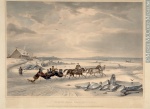 «Course de traîneaux
«Course de traîneaux
près de Montréa... -
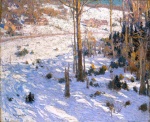 «Habitations sur la c
«Habitations sur la c
olline», 1909 -
 «La rivière Magog», 1
«La rivière Magog», 1
913 -
 «Les coupeurs de glac
«Les coupeurs de glac
e», 1904
-
 «Un péager floué», 18
«Un péager floué», 18
47-1868 -
 Brise-glace Montcalm,
Brise-glace Montcalm,
Cap Rouge, Qué... -
 Brochure de vente d'u
Brochure de vente d'u
n des premiers ... -
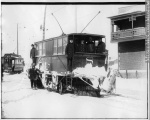 Chasse-neige électriq
Chasse-neige électriq
ue, Montréal, Q...
-
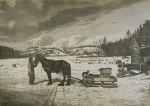 Cheval en raquettes s
Cheval en raquettes s
ur la rivière d... -
 En raquettes (1871)
En raquettes (1871)
-
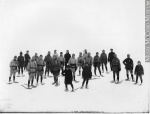 Groupe de raquetteurs
Groupe de raquetteurs
, Montréal, QC,... -
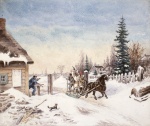 Habitants fuyant le p
Habitants fuyant le p
oste de péage, ...
-
 Hommes hissant une em
Hommes hissant une em
barcation sur l... -
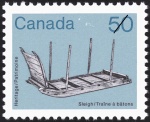 Patrimoine, traîne à
Patrimoine, traîne à
bâtons -
 Photo promotionnelle
Photo promotionnelle
du film Mon onc... -
 Porte Saint-Jean à Qu
Porte Saint-Jean à Qu
ébec, mars 1897...
Catégories
Notes
1. Robert-Lionel Séguin, La civilisation traditionnelle de l'"habitant" aux 17e et 18e siècles, Montréal et Paris, Fides, 1967. p. 586
3. Paul-André Leclerc, « Promenades d’hiver : traînes, berlines, carrioles, sleighs... », Cap-aux-Diamants, no 24, hiver 1991, p. 42-45. Cité dans Sébastien Couvrette, « Criée des âmes à l’Islet-sur-Mer», Encyclopédie du patrimoine culturel de l’Amérique française, 2011.
5. Christian Morissonneau, “Le chemin du Roy, entre Québec et Montréal,” Encyclopedia of French Cultural Heritage in North America, 2011, http://www.ameriquefrancaise.org/fr/article-522/Le%20chemin%20du%20Roy,%20entre%20Qu%C3%A9bec%20et%20Montr%C3%A9al
6. “De 1926 à 1938: Premiers succès,” Musée J.-Armand Bombardier, website consulted on 5 June 2011 [on line], http://www.museebombardier.com/fr/content/jab/biographie1926_1938.htm
9. “...et dessus la terre, y avait la hauteur de quatre pieds de neige et plus, tellement qu’elle était plus haute que les bords de nos navires…” (“...and on the earth, the snow stood four feet high and more, so high that it rose above our gunwales...”), Jacques Cartier, Second voyage (1535–1536), op cit Cazelais, p. 6.
11. Ice bridges are still used on some rivers in Canada. The Federal government’s Safety Guide for Operations over Ice warns that “Ice that is less than six inches (15 cm) thick should not be used for any crossing.” http://www.collectionscanada.gc.ca/eppp-archive/100/201/301/tbs-sct/tb_manual-ef/Pubs_pol/hrpubs/TBM_119/CHAP5_3_e.html, website consulted on 19 October 2012.
Bibliographie
Arcand, Bernard, Abolissons l'hiver! : livre (très) pratique, Montreal, Boréal, 1999, 112 pages.
Bach, Francis, “Des raquettes sur le sentiers de la guerre,” Cap-aux-Diamants, no. 75, 2003, p. 58.
Cazelais, Normand, Vivre l'hiver au Québec, Montreal, Éditions Fides, 2009, 200 pages.
Deffontaines, Pierre. L'homme et l'hiver au Canada, Gallimard, Paris, 1957, 294 pages.
Lamontagne, Sophie-Laurence, L'hiver dans la culture québécoise (XVIIe siècle-XIXe siècle), Quebec City, Institut québécois de recherche sur la culture, 1983, 194 pages.
Lavoie, Richard, “Du transport au sport : le canot à glace” Cap-aux-Diamants, no. 64, 2001, pp. 29–34.
Lavoie, Richard and Genest, Bernard, Naviguer en canot à glace : un patrimoine immatériel, Québec, GID, 2012, illustrated, 240 pages.
Lebel, Jean-Marie, “La belle époque des raquetteurs,” Cap-aux-Diamants, no. 24, 1991, pp. 60–63.
Leclerc, Paul-André, “Promenades d'hiver : traînes, berlines, carrioles, sleighs...,” Cap-aux-Diamants, no. 24, 1991, pp. 42–45.
Séguin, Robert-Lionel, La civilisation traditionnelle de l'"habitant" aux 17e et 18e siècles, Montreal and Paris, Fides, 1967, 702 pages.
Séguin, Robert-Lionel and Beaulieu, Louis-Jacques, “Achimac ou la raquette pour marcher sur la neige et Nouvelle-France,” Vie des Arts, no. 41, 1965–1966, pp. 24–44.
Séguin, Robert-Lionel, “L'habitant et ses véhicules aux dix-sept et dix-huitième siècles,” Revue d'histoire de l'Amérique française, vol. 11, no. 2, 1957, pp. 242–269.
“J. Armand Bombardier Museum,” J. Armand Bombardier Museum, website consulted on 26 April 2011 [online], http://www.museebombardier.com/.
“Les voitures d’hiver,” Musée François-Pilote, La Pocatière, website consulted on 26 September 2012, http://www.museefrancoispilote.ca/C2C31E94-13F2-48C1-A04D-400B11E0A6E5.html.

